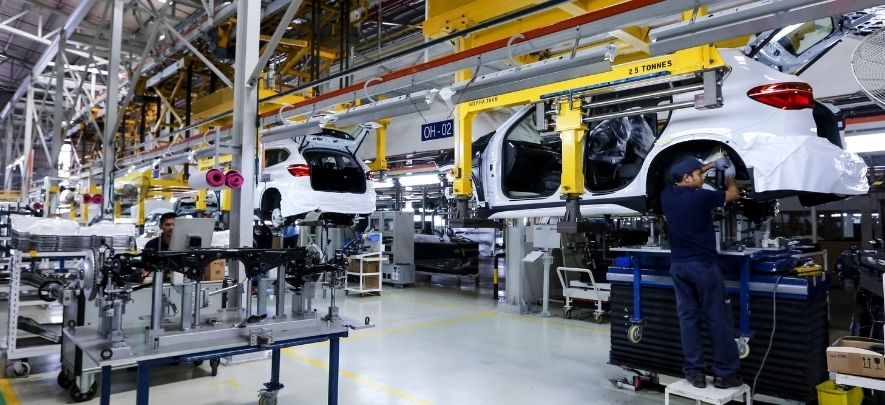Automotive industry and relevant laws

Legal & Compliance
235 week ago — 26 min read
Automotive industry – Overview
The automotive industry in India is the fastest growing industry in the world. India’s automotive industry is considered to be the fourth largest in terms of production, marketing, and sales sector, with the scale of production increasing 9.5 per cent year on year. It is one of the most dynamic sectors of the Indian economy with most of the global automotive giants already present in the market and contributing to its growth.
Over the last few decades, the country has established a firm footing in the manufacturing sector and now is the seventh-largest manufacturer in the world. Moreover, in both -primary and secondary automobile markets in India have developed. This is to witness most reputable international automotive manufacturing companies compete for market share.
Also read: 3D printing to improve manufacturing productivity & lower costs
Industry scenario
-
India’s annual production has been 30.91 mn vehicles in 2019 as against 29.08 mn in 2018, registering a steady increase of 6.26%
-
India is anticipated to come up as the world’s third-largest passenger vehicle market by 2021. During the FY 2018-19, sales of passenger vehicles have increased by 2.70%, two-wheelers by 4.86%, and three-wheelers by 10.27% as compared to FY 2017-18.
-
In April-March 2019, overall automobile exports grew by 14.50%. The overall Commercial Vehicles segment registered a growth of 17.55% in April- March 2019.
-
Further, the demand for premium and luxury vehicles and motorbikes in India has witnessed tremendous growth with companies witnessing a growth of 11% growth in sales year-on-year.
-
India is a projecting automobile exporter with overall automotive exports growing at 15.54% between April 2018 and February 2019. Additionally, according to a statistical report of the Society of Indian Automobile Manufacturers (SIAM), the exports of passenger vehicles have constituted the maximum share of the segment over the past few years.
Growth trends of the industry
The automotive industry in India is the fastest growing industry in the world. It is considered to be the fourth largest in terms of production, marketing, and sales sector, with the scale of production increasing 9.5% year on year.
-
India’s automobile market is quite different from other top automobile markets in terms of demand for two-wheelers constituting 80% of the total demand.
-
Further, growth is driven by attributes such as affordability, fuel economy, and alternate fuels.
-
The rural market is still relatively untapped and holds great potential for the Indian automotive industry.
-
Moreover, large scale acquisitions can facilitate Indian expertise in supply-chain efficiency and lower production costs to foreign manufacturers, in addition to providing greater choice for the Indian customer.
-
The commercial vehicle is subject to take a great hike in the next few decades due to the rise in Government spending on public transport which is a result of the strained road infrastructure in most big cities in India.
Reasons for a slowdown in the industry
-
Some reports suggest that nearly about 3.5 lakh automotive jobs in India have been cut since April 2019 and more than 200 dealerships were closed down. Further, these numbers are likely to go up as the downward trend continues.
-
Additionally, in July 2019, the sale of vehicles across categories in the country slumped 18.71% to 18.25 lakh units, down from about 22.45 lakh units, a year ago in the same month. This has been the steepest fall in nearly 19 years.
-
Domestic passenger vehicle sales declined for the first time after nine months in July 2018. In July 2017, vehicle sales spiked due to the benefits extended by the rollout of the GST. However, demand failed to pick up in August and September, after the floods in Kerala and heavy rainfall in several other States.
-
Consumer sentiment remained subdued as the total cost of vehicle ownership went up largely due to an increase in fuel prices, higher interest rates, and a hike in vehicle insurance costs. In such an environment, the festive season too failed to boost demand, leading to a huge inventory pile-up with dealers.
-
The IL&FS crisis late last year led to a severe liquidity crunch, almost drying up credit for dealers and customers.
-
It became very difficult to acquire loans from the banks and financial institutions as banks were more stringent towards giving loans to only those customers with good credit scores.
-
As a result of all these factors, all vehicle categories, including commercial vehicles and two-wheelers, began experiencing negative growth beginning December setting alarm bells ringing.
Current situation
-
The industry currently manufactures 26 mn vehicles including Passenger Vehicles, Commercial Vehicles, Three Wheelers, Two Wheelers, and Quadricycles in April-March 2020, of which 4.7 mn are exported.
-
India holds a strong position in the international heavy vehicles arena as it is the largest tractor manufacturer, second-largest bus manufacturer, and third largest heavy trucks manufacturer in the world.
-
In April-March 2020, overall automobile exports registered a growth of 2.95%. Passenger Vehicles exports marginally increased by 0.17% and Two-wheelers exports registered a growth of 7.30% in April-March 2020 over the same period last year.
-
The sector attracted $24.5 bn FDI during April 2000 – June 2020; accounting for 5.1% of the total FDI inflows.
How to start an automobile industry in India
OEM and Brand assembling manufacturers
When referring to auto parts, OEM refers to the manufacturer of the original equipment, that is, the parts assembled and installed during the construction of a new vehicle.
In contrast, aftermarket parts are those made by companies other than the OEM, which might be installed as replacements after the car comes out of the factory.
Legislative framework governing automobile industry in India
Setting up business laws
| Legislation | Effect of the Legislation (Crux of the Act) |
| The Companies Act, 2013 | Registration of industry as a Company- either public limited or private limited. This Act shall also provide guidelines relating to the management of affairs of the industry. |
| The Partnership Act, | Registration of the industry as a partnership firm which will govern the acts and deeds of the partners of the healthcare business. |
| Society Registration Act –1960 | Registration of the industry as a cooperative society. |
| Government Buildings Act,1899 | An Act to provide for the exemption from the operation of municipal building laws of certain buildings and lands which are the property, or in the occupation, of the Government and situate within the limits of a municipality. |
| The Electricity Act, 2003 | An Act to consolidate the laws relating to the generation, transmission, distribution, trading and use of electricity. Generally, for taking measures conducive to the development of electricity industry, promoting competition therein. Additionally, protecting the interest of consumers and supply of electricity to all areas, rationalisation of electricity tariff. Further, ensuring transparent policies regarding subsidies, promotion of efficient and environmentally benign policies, the constitution of Central Electricity Authority, Regulatory Commissions and establishment of Appellate Tribunal and for matters connected therewith or incidental thereto. |
| Indian Telegraph Act | This Act intended to give the Central Government power to establish telegraph lines on private as well as public property. |
| The Shop and Establishment Act, 1953 | To regulate the conditions of work and employment in shops, commercial establishments, residential hotels, restaurants, eating houses, theatres, and other places of public entertainment. |
| The Factories Act, 1956 | The Act aims to regulate the working conditions in factories, to regulate health, safety welfare, and annual leave, and enact a special provision in respect of young persons, women, and children who work in the factories. |
Regulatory Laws
Motor vehicles Act, 1988
The MVA vests authority with the central and state governments to make and implement rules regulating the construction, equipment, and maintenance of automobiles with respect to several aspects including dimensions, emission norms, automobile parts such as brakes, steering gears, safety devices and warranty after-sales. Moreover, the central government primarily administers and regulates the industry through its apex wing, the Ministry of Road Transport and Highways.
Insurance of an automobile is compulsory before the automobile can be driven in a public place. Additionally, insurance of an automobile is provided by an authorised insurer, which issues a certificate to the policyholder. Further, an insurance policy is usually valid for one year and is required to be renewed before the due date. The MVA mandatorily requires the insurance policy to cover third-party risks.
Central motor vehicle rules, 1989
The manufacturing and maintenance of an automobile must comply with the parameters and standards as prescribed under the CMV Rules and those notified by the central government from time to time.
Further, a manufacturer or importer that proposes to manufacture or import a new automobile is required to obtain approval of the prototype of such an automobile from the designated testing agencies.
The procedure for type approval and certification of automobiles for compliance with the MVA and CMV Rules should accord with the Automobile Industry Standards as prescribed and notified by the central government. Additionally, while the production of automobiles is ongoing, the CMV Rules require conformity of production. Moreover, this tests to be conducted periodically on automobiles drawn from the production line to verify that they conform to the approval certification.
Upon manufacturing being completed and sale of an automobile, the manufacturer has to issue a certificate of roadworthiness. Further, quality to the owner, and thereafter, for in-use vehicles, owners are required to obtain pollution under control (PUC) certificate a year after the date of its registration.
Taxation laws
Income Tax Act, 1961: Transfer pricing regulations
The Income Tax Act has provisions that make provisions for taxation of income arising from transactions between associated enterprises. Further, Transfer Pricing Regulations lay down that any income arising from such an “international transaction” shall be computed having regard to the “arm’s length price”. Likewise, the regulation also lays down the method to calculate the tax. Further, since it is already discussed above that the Automotive Sector in India is one of the largest in the world. Additionally, producing almost 20 million units a year, the industry is often subjected to rigorous transfer pricing scrutiny; which may lead to slower growth in the Automotive Sector.
Custom duty
Customs duty is charged when any product is imported to India. Moreover, automobile manufacturers based in foreign countries who want to avail lower custom duties. Additionally, pass on the benefits to the customers can import Completely Knocked Down Kits (CKD) Kits which are charged concessional Customs duty.
|
Criteria / Applicability |
Import Duty in % |
|
Used car import |
125 |
|
Cars CBUs whose CIF value is more than $ 40,000 or Petrol Engine > 3000 CC or Diesel engine > 2500 CC |
100 |
|
Cars CBUs whose CIF value is less than $ 40,000 and Petrol Engine < 3000 CC and Diesel engine < 2500 CC |
60 |
|
Two-wheeler CBUs |
50 |
|
Commercial Vehicle CBUs (Trucks & *****) |
30 |
|
CKD containing engine or gearbox or transmission mechanism in pre-assembled form but not mounted on a chassis or a body assembly (Passenger Vehicles) |
30 |
|
CKD containing engine or gearbox or transmission mechanism in pre-assembled form but not mounted on a chassis or a body assembly (Two-wheelers) |
25 |
|
CKD containing engine or gearbox or transmission mechanism in pre-assembled form but not mounted on a chassis or a body assembly (Commercial Vehicles) |
25 |
|
CKD containing engine, gearbox, and transmission mechanism, not in a pre-assembled condition |
15 |
Research and development cess act, 1986
Moreover, all payments made towards the import of technology are subject to a cess of 5% under the Act.
Technology includes any special or technical knowledge or any special service required for any purpose. Additionally, whatsoever by an industrial concern under any foreign collaboration and includes designs, drawings, publications, and technical personnel.
Environment and Safety Regulations
Environment Protection Act, read with Environment (Protection) Rules 1986
The MVA read with the CMV Rules authorises the central government to notify, from time to time- Quality, Safety and Performance Standards, the standards about any part, component or assembly to be used in the manufacture of an automobile.
Every manufacturer is required to obtain the prototype of the part, component, or assembly for which standards have been notified and approved by any agency referred to in rule 126 of the CMV Rules. Likewise, after obtaining approval, every manufacturer shall also certify compliance with the statutory form prescribed under the CMV Rules.
Additionally, the Ministry of Environment and Forests has laid down rules to ensure that standards for emissions of air pollutants from automobiles are kept in consonance with the international standards.
Schedule IV of the Environment (Protection) Rules 1986 provides for standards for emissions of smoke, vapour, etc, from automobiles. Moreover, the Bharat Stage Emission Standards (based on European regulations) are emission standards. Likewise, this has been set up by the central government to regulate air pollutants from internal combustion engine equipment, including motor vehicles.
Currently, the vehicle emissions standards adopted throughout the country are the Bharat Stage IV or BS-IV. Additionally, the MVA requires every automobile owner to carry a valid PUC certificate; Further, which is issued by the designated checking facilities to certify compliance with the prescribed emission norms.
The current emission standards applicable in India are due to be updated very shortly; with the Ministry of Road Transportation and Highways; amending the CMV Rules to mandatorily require every vehicle manufactured on or after 1 April 2019 to be compliant with the new Bharat Stage VI (BS-VI) emission standard.
Additionally, the MVA prescribes punishment by way of a fine in the event a person is found to be driving an automobile in any public place that violates the standards prescribed about any road safety and pollution.
Competition regulations
Competition Act, 2002
The Competition Commission of India (CCI) (the authority regulating competition in India) actively investigates allegations of anti-competitive behaviour in the automotive sector. Moreover, the CCI observed that owing to technical specifications of the cars manufactured by; each original equipment manufacturer (OEM), the spare parts of one brand cannot be used for the repair and maintenance of cars manufactured by another OEM. Moreover, since the spare parts of one OEM are not interchangeable with those of other OEMs, each OEM is shielded. Additionally, shielded from the competition in the aftermarket from the existing competitors in the primary market.
Moreover, each OEM holds a position of strength, which enables it to affect its competitors in the secondary market. Thereby, limiting consumer choice and compelling consumers to behave in a manner beneficial to the OEMs. Additionally, this allows them to enjoy a dominant position and strength in the aftermarket for spare parts.
The agreements entered into by OEMs with their original equipment suppliers (OESs); authorised dealers to prohibit the sale of spare parts to independent repairers in the secondary market. Further, the CCI was of the view that each OEM holds a position of strength. Further, this enables it to affect its competitors in the secondary market or aftermarket. Thereby, limiting consumer choice and compelling consumers to behave in a manner beneficial to the OEMs. Similarly, which allows them to enjoy a dominant position and strength in the aftermarket for spare parts.
Employment-related legislations
|
Payment of Wages Act – 1936 |
The Payment of Wages Act, 1936 (the Payment of Wages Act) is an Act to regulate the payment of wages to certain classes of employed persons. Moreover, the Payment of Wages Act seeks to ensure that the employers make timely payment of wages. |
|
Industrial Disputes Act – 1947 |
The ID Act provides for the constitution of the Works Committee; consisting of employers and workmen; to promote measures for securing and preserving amity. Further, good relations between the employer and the workmen and, to that end, endeavours to resolve any material difference of opinion in respect of such matters. |
|
Factories Act, 1956 |
The Factories Act, 1948 (the Factories Act) lays down provisions for the health. Further, safety, welfare and service conditions of workmen working in factories. Additionally, it contains provisions for working hours of adults, employment of young persons, leaves, overtime, etc. |
|
The Employee’s Compensation Act, 1923 |
The Employee’s Compensation Act, 1923 (the EC Act) aims to provide financial protection to workmen and their dependents. Additionally, in case of any accidental injury arising out of or in course of employment and causing either death or disablement of the worker by means of compensation. |
|
Minimum Wage Act – 1948 |
The Minimum Wages Act, 1948 (the Minimum Wages Act) provides for fixing of minimum rates of wages in certain employments. Further, the minimum wages are prescribed by States through notifications in the State’s Gazette. |
|
ESI Act – 1948 |
The Employees’ State Insurance Act, 1948 (the ESI Act) is social welfare legislation enacted with the objective of providing certain benefits to employees. This in case of sickness, maternity and employment injury. In terms of the provisions of the ESI Act, the eligible employees will receive medical relief. Additionally, cash benefits, maternity benefits, pension to dependents of deceased workers and compensation for fatal or other injuries and diseases. |
|
Employees Provident Fund and Misc. provision Act – 1952 |
The Employees Provident Funds and Miscellaneous Provisions Act, 1952 (the “EPF Act”) provides for the institution of provident funds; pension funds, and deposit-linked insurance funds for employees; and applies to all establishments employing 20 or more persons or class of persons. Additionally, an establishment to which the EPF Act applies shall continue to be govern by this Act; notwithstanding that the number of persons employed therein at any time falls below 20. |
|
Payment of Bonus Act – 1965 |
The Payment of Bonus Act, 1965 (the “Bonus Act”) provides for the payment of bonus to persons employed in certain establishments. Further, in India either on the basis of profits or on the basis of production; or productivity and applies to every establishment in which 20 or more persons are employed and to all employees drawing remuneration of less than Rs 10,000. |
|
Payment of Gratuity Act – 1972 |
The Gratuity Act provides for a scheme for the payment of gratuity to employees engaged in factories. Additionally, mines, oilfields, plantations, ports, railway companies, shops or other establishments. Further, the Gratuity Act enforces the payment of “gratuity”, a reward for long service, as a statutory retiral benefit. |
|
Equal Remuneration Act -1976 |
The Equal Remuneration Act, 1976 provides for the payment of equal remuneration to men and women workers. Further, for the same work and prevents discrimination, on the ground of ***, against women in the matter of employment. Additionally, recruitment, and for matters connected therewith or incidental thereto. Further, this Act applies to virtually every kind of establishment. |
|
The Shop and Establishment Act, 1953 |
To regulate the conditions of work and employment in shops, commercial establishments, residential hotels, restaurants, eating houses, theatres and other places of public entertainment. |
|
Maternity Benefit (Amendment) Act – 2008 |
Maternity Benefit Act, 1961 (Maternity Benefit Act) regulates the employment of women in certain establishments for a certain period before and after childbirth and provides for maternity benefits and certain other benefits including maternity leave, wages, bonus, nursing breaks, etc, to women employees. |
|
Sexual Harassment at the Workplace (Prohibition, Prevention and Redressal) Act, 2013
|
The sexual Harassment at Workplace (Prohibition, Prevention and Redressal) Act, 2013 (SHW Act) was enacted by the Parliament to protect against sexual harassment of women. Further, it is at the workplace and prevention and redressal of complaints of sexual harassment and for matters connected therewith. |
|
Trade Union Act, 1926 |
An Act to provide for the registration of Trade Unions and in certain respects to define the law relating to registered Trade Unions. |
Intellectual property regulations
| Trademark Act, 1999 | This Act provides for registration and better protection of trademarks for goods and services and for the prevention of the use of fraudulent marks. |
| Copyright Act,1956 | This Act provides for registration and protection of copyrightable work- websites in particular and for the prevention of the use of fraudulent materials. |
| Indian Patent Act, 1970 | Any new invention in terms of technology and technique can be granted protection when registered with the concerned authority. Similarly, the software developed by automotive industries for further enhancement of the functions of the automobiles is also protected. |
| Designs Act, 2000 | The aesthetic look of an automobile is the ultimate commercial feature of any automobile company. Further, automobile leaders such as Mercedes, GM, Honda, Toyota, Tata, Bajaj. Further, many more have already established their own brands with unique design impressions. Moreover, these industrial designs are extended protection under the Design Act 2000 upon registration with the relevant authority. |
New legal updates in the automobile industry
The Government of India has attempted to introduce legislation to regulate advancements in automotive and mobility technology. However, most has not yet become law and is still in the nascent stages of development.
Such legislation includes the Geospatial Information Regulation Bill 2016, which proposes to regulate the acquisition, dissemination, publication, and distribution of geospatial information. Additionally, this includes geospatial imagery or data acquired through space or aerial platforms. Further, such as satellites, aircraft balloons, or graphical or digital data depicting natural. Additionally, man-made physical features, phenomena, or boundaries of the earth. The bill proposes the creation of a Security Vetting Authority.
The government of India has also launched several schemes to encourage the growth of the automotive sector, such as:
-
The Automotive Mission Plan 2016, which objects to increase domestic production of automobiles, increase automotive exports and address environmental and safety challenges;
-
Moreover, the National Automotive Testing and R&D Infrastructure Project, which has been set up to enable the industry to adopt and implement global performance standards by establishing nationwide automobile testing agencies;
-
Additionally, the National Electric Mobility Mission Plan 2020, which delivers incentives to manufacturers of and purchasers of electric cars; and
-
Further, the Faster Adoption and Manufacturing of (Hybrid) and Electric Vehicles in India) the scheme, which offers monetary incentives to producers and purchasers of eco-friendly vehicles in the country. Moreover, the government of India approved the second phase of the scheme in February 2019.
To explore business opportunities, link with us by clicking on the 'Connect' button on our eBiz Card.
Image source: shutterstock.com
Disclaimer: The views and opinions expressed in this article are those of the author and do not necessarily reflect the views, official policy or position of GlobalLinker.
Posted by
Vakilsearch StaffGreetings! We would love to work with you and your company. We look forward to connecting with business houses and MSME's.
View Vakilsearch 's profile
Other articles written by Vakilsearch Staff
Know About the 4 Types of Partnership Firms
49 week ago
Most read this week













Comments
Share this content
Please login or Register to join the discussion